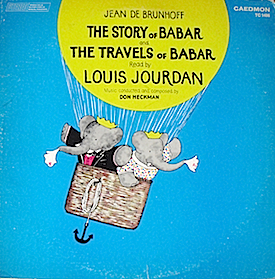

While Cécile de Brunhoff is often credited with thinking up the story and characters, the visual style of 'Babar' was completely Jean's work. The work was published as 'Histoire de Babar' ('The Story of Babar', 1931) and became an instant bestseller. Brunhoff's children liked the story so much that they asked their father to write it down and illustrate it. Babar is crowned his successor, marries Celeste and molds the jungle according to human civilization and ethics. They return to the jungle and learn that the elephant king has recently passed away. By the time Babar's cousins Celeste and Arthur have located him, Babar is basically a civilized animal. She dresses and tutors him as if he's a human. Babar flees and discovers a city, where he is adopted by a rich old human lady, literally named 'Christelle, la Vieille Dame' ("Christelle, the Old Lady"). When De Brunhoff's sons Laurent and Mathieu were respectively four and five years old, their mother told them a bedtime story about an elephant, Babar, whose mother is shot by a hunter.


He married Cécile Sabouraud in 1924, with whom he would have three sons: Laurent (1925), Mathieu (1926) and Thierry (1934). After the war he studied painting at the Académie de la Grande Chaumière in Paris. Near the very end of World War I he fought in the trenches. Jean de Brunhoff was born in 1899 in Paris, as the son of a publisher. The most astonishing aspect about De Brunhoff's success, however, was that he was completely self-taught. The franchise inspired countless novels, was translated all over the globe and adapted into TV series and films. Created in 1931, the pachyderm monarch has become one of the all-time classics of French children's literature. Jean de Brunhoff was a French children's writer and illustrator, most famous as the creator of the world famous book series about 'Babar' the elephant.


 0 kommentar(er)
0 kommentar(er)
